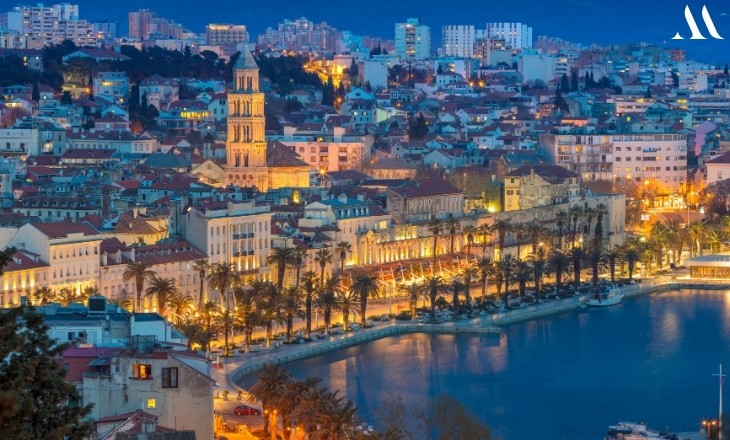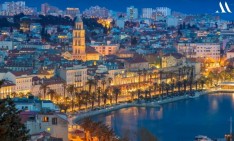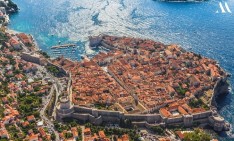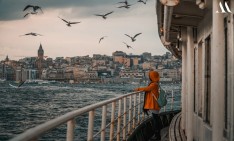Croatia, one of the oldest European countries in terms of history and culture, once kept under the radar, is now finding its rightful place internationally as the world is waking up fast to this magnificent Adriatic jewel.
As one of Europe’s Mediterranean hot spots in summer, Croatia puts forth an enchanting combination of offshore islands, thickly wooded national parks, historical walled towns and glittering azure seas. With its swanky harbour restaurants, cocktail bars and luxury accommodation, it certainly has appeal for wealthy travellers and a vibrant night scene, all adding to its appeal for both older and younger solos.
But there’s more to Croatia than expensive hotels and beach resorts. History enthusiasts will fall in love with towns like Split and Dubrovnik and sunny cities crisscrossed by winding cobblestone streets, representing a fascinating past that stretches from prehistoric times to modern-day struggles. Whereas, nature lovers will love the blue gem lakes set amongst white-capped mountains, a crystalline sea, flora and fauna of the remote Kornati Islands and the hiking around the glorious national parks, Plitvice Lakes and Krka. Besides, the lively & colourful festivals, great food and wine add glamour to the days and nights spent, and you will likely feel you need more time here.
When to Go
The coast of Croatia has a Mediterranean climate with hot summers and relatively mild winters. Inland areas will bring warm to hot summers and cold winters, though snow accumulation has declined in recent years.
July and August are the busiest months on the coast—beaches and nightclubs are crammed, and many coastal towns host colourful festivals. But these months are the worst to visit as temperatures soar and hotels are sold out and practically makes the coast a tourist overkill.
June and September are idyllic for visiting the coast or inland cities. The waters are balmy for swimming, and the biggest lot of visitors arrive between these relatively peaceful months.
If you are not much into water activities, then March, April, May, and October are probably even better—an early-morning meandering around the gorgeous old towns through secret alleyways may make you think you’re the first to discover a destination.
Autumn is here is lovely. Great season for visiting Istria and inland Croatia; Vines are harvested, leaves turn to shades of gold, and the crisp air is invigorating, the best way to explore the countryside.
Winter is the off-season; most hotels and restaurants are at their cheapest when you might have some places all to yourself. Inland Croatia is cold and grey in winter; also some hotels and restaurants will be closed, particularly on the islands. But December festivities and markets bring life to Zagreb.
Getting Around
Public transportation is an excellent option for getting around in Croatia. Buses and trains are frequent, safe, and reliable. Islands are well connected via ferry.
Croatia Airlines has domestic flights between Zagreb and most major towns in Croatia, including Dubrovnik, Split, Pula, Rijeka and Zadar (note that tickets are much cheaper when purchased in Croatia)
This works well if you’ll be sticking to larger towns, but if you’re planning on exploring smaller villages or following the regions’ wine routes, you’ll find renting a car is more convenient. It is advisable to pre-book the car.
Additionally, bicycles are best suited for the sleepy coastal islands.
While in Croatia You will Find
Where to stay
Croatia offers a wide range of hotels, from clean and functional resort hotels to luxurious business-oriented hotels and cosy boutique hotels. Hotels in the popular coastal regions sell out quickly for July and August, so you will want to reserve ahead (mostly to get a good room versus an overpriced mediocre one); otherwise, you can just show up and find a room in all except the most rural locations—which may have no accommodations at all. Be advised some accommodation may have a confusing star system. Private accommodation is popular in Croatia, although the standard may vary considerably, ranging from simple rooms in private houses (called sobe) to self-sufficient studios or apartments, ideal for longer visits. Besides, if you want to experiment and seek a unique holiday experience, you can also stay in one of the 13 renovated lighthouses in Croatia.
About the Past
Sharing borders with Slovenia, Hungary, Serbia, Montenegro, and Bosnia and Herzegovina, Croatia is part of former Yugoslavia.
You will find many remnants of the 1991–95 Homeland War that tore the former Yugoslavia apart. But Vukovar, which stood between Serb and the rest of Croatia, was devasted. Approximately 1,800 self-organised and lightly armed Croatian National Guard and civilian volunteers fiercely defended the city for 87 days against 36,000 troops of the Serb-dominated JNA during the siege.
Croatia has spent the following years steadily evolving itself into one of the most coveted destinations in Europe. It has judiciously emphasized the existence of the crossroads of culture and history within itself.
The UNESCO World Heritage List such as the palace of the Roman emperor Diocletian, the Ancient Greek field in Stari Grad on Hvar, the early Christian Euphrasian Basilica in Porec, the Romanesque centre of the town of Trogir, the early Renaissance Cathedral of St James in Šibenik, and Renaissance Dubrovnik are few of the classic monuments that draw huge attention worldwide.
Today this peaceful country attracts those who come for its dramatic coastline, Renaissance walled towns and, of course, its Croatian charm.
The Coastline
The coastline boasts over 50 marinas in operation, offering various facilities; restaurants, café, bars, toilets, showers, parking lots, grocery shops, and much more. There are a few hundred ports as well, used primarily by the local inhabitants but can be used for yachts too.
You will enjoy a sailing trip. Not only is this a great way to see more than one island, but you also get to sleep aboard a yacht and experience the Adriatic sea and coastline as you sail along.
Croatia is a paradise for the adventurous; the Adriatic coast has ripe spots for scuba diving, sailing and other watersports. There are dive centres along the Croatian coastline. Scuba diving is strictly monitored here. No one is permitted to dive without first obtaining a diving certificate, which costs 100kn unless you acquire further permission to dive independently, which is pretty expensive - approx 2,400kn.
The long coastline has many beaches to relax on and islands not far off to explore. Inland you can go rafting and canoeing on the rivers or trekking in the mountains.
The People
Most Croatians citizens speak at least one other language along with Croatian. In the coastal regions, German and Italian are common. If English is your first and only language, don’t fret! Tourism is one of the major drivers of the economy, so English is widely spoken and understood in tourist-centric areas. Most Croatians under 45 speak understandable English.
Some travellers complain of poor service, even at luxury establishments. This could be the case amongst the seasonal workers because the unemployment rate is high, and many people take seasonal jobs.
Also, tourists have complained people here are rude or abrupt. This could be coming more from the older generation, a holdover from the communist regime. If you do experience it, try to have a sense of humour and not let it spoil your vacation. Also, consider their history. There was a war not thirty years ago, and they've been thrust into a completely capitalist world.
Despite their turbulent recent history, you'll find the locals are welcoming and friendly though they seem a little reserved at first. Nevertheless, they're extremely responsive and helpful to tourists.
-1602326615.jpeg)
How expensive is Croatia?
It is moderately expensive. At least for Western tourists, it will not seem a lot. However, prices are as per the popularity of the locations, where it's the seasonal time for tourists or offseason. Eating out is not as expensive as in Swiss, Germany or Italy. An estimated expense could be $20-$100 per day.
For cheap but good lunch or early meal, look out for restaurants with special menus for marenda and gablec. These are popular local dishes and are only cooked and served in late morning hours or between breakfast and lunch. The meals cost no more than $7-$8.
Accommodation could be anywhere between $10-$350 (USD) per night, depending on the season and category of the hotel or homestay. Prices of hostels vary quite a lot, anywhere from $10 to $55 per night.
For local bus transportation, you can purchase 24-hour ticket passes for just under $5.
Travelleing with kids
While travelling with kids, you’ll find that almost every city has at least one igraonica (play centre). Many attractions are open to children, with free or discounted admission. You will find everything your little ones need in any supermarket, whether you are on the mainland or the islands.
You will find a wide choice of pasta and risottos in all the food joints and pizzerias and ice creams across Croatia. But it's advisable to introduce your kids to different types of food so that they adapt and learn about new food. Beaches are a major draw specifically for young children; teens will appreciate sights like Rovinj’s museum for the batana boat, and the mummy at Zagreb’s archaeological museum.
Safety for Women travellers
Croatia is safe for women to travel alone or in a group, and it's unlikely you will encounter any real problems. But expect to be hit on by the locals, mostly if you go to a bar or disco—it’s probably better to find some travelling companions at your hotel or hostel to go out with.
Though Croatia's crime rate is low by European standards, that doesn’t mean you should be careless about safety. Basic common sense should keep you safe: Be cautious of strangers; drink but have your wits about; avoid walking on dark empty streets alone, and don’t flaunt money or jewellery and most importantly, be alert.
Wearing scanty beachwear is acceptable on the beach itself, but considering local sensibilities, you’re advised to cover up if visiting bars or restaurants or using local transport to commute.
Croatian cuisine
Croatian cuisine is a mix of influences reflecting its particular geographical position with a rich variety of regional cuisines. Croatia is particularly proud of its top-quality olive oil and selected indigenous wines. Eating out is one of the highlights of travelling to Croatia. You won’t have to look far to find somewhere specialising in fresh local delicacies as more and more are becoming available to foreign guests as part of the range of tourist services. There are also many places serving international cuisine, especially Italian.
Check out our list of Must-Try Dishes while in Croatia. 22-dishes-that-you-must-try-while-in-Croatia
Traffic Sense
Hiring a car for a road trip along Croatia's stunning coastline is an absolute joy and one that should not be missed. But if you're on a tight schedule, you'll need to consider the traffic, as the roads can get very busy in the peak season. Croatia has a right-hand-side drive on the road rule; make sure you are prepared for it.
It's sensible to keep your wits about you and a firm grasp on your child’s hand as a pedestrian as well. Croatians are not absolute followers of the rules as the Brits, so never assume that just because you're about to step on to a pedestrian crossing, motorists will necessarily stop. Check and double-check.
A simple city map, most tourist offices and sometimes hotels provide you with is suitable for a walk around town. You can also buy them at bookshops and gas stations.
Let's talk about money.
The Croatian unit of currency is called the kuna (Kn or HRK). Coins are available in 1, 5, 10, 20, 50, and 100 lipa and larger notes (currently 5, 10, 20, 50, 100, 200, 500, and 1,000). 100 lipa make 1 kuna.
Money exchange in Croatia is very straightforward. Mjenjačnica (exchange bureaus) are spread all over the larger towns and cities and usually give the best rates. Avoid the exchange at bus and train stations; they tend to give poorer rates. ATMs are common in major towns and cities and charge you a usage fee for withdrawing money. Cash is preferable to traveller’s cheques. Also, some places, particularly small stores and businesses in smaller towns, may only take cash. Some stores and restaurants also offer discounts for paying with cash.
Additional information
It's important to pack some comfortable rubber-soled shoes, especially for seeing the museums and monuments in the old towns, where cobblestoned streets can turn slippery for flat-soled sandals and may catch even medium-size heels between their grooves.
Croatia uses the metric system, and the electrical system is 220 volts, 50 hertz. Most newer appliances have dual-voltage capability; if not, you’ll need a voltage converter. Plugs in Croatia are the typical European variety, two-pinned with round prongs.
Did you Know
Croatia was first acknowledged on 7 June 879, when Pope John VIII granted Duke Branimir the title dux Croatorum.
The Folk Music
You will find opportunities to appreciate the rich indigenous folk music (which is not played widely) on the coast, and the foremost folk music is the klapa. Many Dalmatian towns hold klapa festivals in the summer – the most famous is at Omiš, just south of Split in July. It’s recommended to attend a klapa festival if you have the chance. But if you travel inland to any traditional towns and villages, you may be walking down a street to the sounds of choirs in rehearsal drifting out from behind closed doors. The tambura is the most important instrument in Slavonian folk music, but the Istrian peninsula’s distinct music has specific styled instruments—like the Sopila, a type of large oboe, and the Mijeh, a bagpipe made from goat bladder—that truly make the music unique as a whole.
Attending festivals here will give insights into local arts and culture; shopping, entertainment, and nightlife are all in plenty.
The country’s major festivals include
The Dubrovnik Summer Festival (July–August). The country's oldest cultural festival brings together local and international creativity through a diverse programme of theatre, ballet, opera and classical music across various venues. Some of the world's most revered composers, musicians and dancers display their talents against the magical backdrop of Dubrovnik's ancient walls.
The Alka, a form of jousting tournament held in Sinj (August)
The Zagreb International Folk Festival (July).
The Pula Film Festival (July).
The Rijeka Carnival (second largest in Europe) and the Samobor Carnival (both February).
Independence Day (25 June) will certainly involve some form of local celebrations, wherever you are.
And, those on Korčula should not miss the Moreška, an elaborate sword dance which is performed about twice a week during August.
The delights for Nature Lovers
There are 8 designated national parks, usually abbreviated to the prefix NP & further 11 areas are designated ‘nature parks’, park prirode, or PP. The entrance fee is applicable for entering a national park. Plitvička jezera and Paklenica collect it at the entry point, whereas in Risnjak and Sjeverni Velebit, it is collected at the staffed mountain hut.
Tickets are available for 3, 5 or 7 days – so you can buy one to cover the time you plan to stay within the park. Prices are reasonable for the western visitor. You should hold on to your ticket to show at subsequent huts. Camping is prohibited in national parks.
Plitvice Lakes National Park
This stunning UNESCO World Heritage Site boasts unique karst morphology and hydrology, with magnificent travertine waterfalls and lakes. It is situated near the border of Bosnia and Herzegovina and is almost 300 square km in size. . It takes 2-3 hours from Zagreb or Zadar, which are closest to this Plitvice Park. It houses 16 lakes divided into upper and lower groups, including the highest Prošćansko (jezero) lake and the largest and deepest Kozjak lake. Renowned for the astounding shades of blue and green coloured lakes, together with the waterfalls cascading over the travertine, making it a fairy tale place.
You can take trails of varying lengths (four to eight hours) that will take you right to the waterfalls and lakes, in addition to taking a boat trip across the largest lake. This is also your chance to see nature at its most untouched as many rare plant and animal species have been conserved without human interference. There are trees nearly 700 years old and rare animals and birds found in parts of the park such as lynx, wolf, golden eagles, the brown bear and at least 321 species of butterflies. The crystal clear lakes are home to many varieties of fish.
Krka National Park
The park is situated on the central coast just north of the city of Šibenik and is one of the area’s top attractions. Krka Park covers an area of just over 142 square km and was created in the mid-1980s as a heritage site to protect the Krka River. It is home to rare sea otters, wild cat, horseshoe bat, and other species like herons, geese, ducks, and several non-poisonous snake species, like the leopard snake. The flora includes hedge beech and scrub, macchia, and some wild bushes also grow wild olives, oleanders, laurel, myrrh, holm, and cork oaks.
The highlights are Skradinski Buk, where the Krka River flows over the karst landscape and lush vegetation. You can take a boat tour from here to visit Visovac Island, a 15th century Roman Catholic Monastery founded by Franciscan monks. Another route for a boat ride is to Roski Slap, the 2nd highlight with a walking trail and wonderful views all around.
Not had enough? Need more interaction with nature? Well then …
Near the eastern border of Croatia is Kopački Rit, a wetlands nature preserve for rare animal species and filled with the area’s indigenous wildlife, including cormorants, herons, lots of fish, wild pigs, and deer. The Lonjsko Polje near the town of Sisak is the place for hundreds of storks that populate the area and home to original folk architecture.
The lush green mountainous region Gorski Kotar between Karlovac and Rijeka is dense with maple, beech, fir, and spruce. Many deer, brown bears, and lynx inhabit the region. Bijele Stijene and Samarske Stijene in Gorski Kotar and Hajducki Kukovi and Rožanski Kukovi, in the area of North Velebit National Park, are strict reserves. The Velebit Range boasts the highest range of plant life, with over 2,500 species, including the endangered edelweiss.
Risnjak, Paklenica and North Velebit are mountainous areas with characteristic features, such as sedimentary rocks, limestones, dolomites and deep canyons, with high meadows and extensive woods and home to many endemic species.
Cres, one of the northern islands in the Kvarner Gulf, is a haven for the Old World Vulture Eurasian giant griffon and the northern part of the islands have red oak, elm, and chestnut.
The Brijuni islands, the fourteen islands and islets in Istria off the northern coast, include cultivated parks and precious cultural and historical heritage from antiquity. The islands are mainly covered with Maquis shrubland, Holm Oak, and Laurel forest, and Conifers.
Kornati Islands National Park between Sibenik and Zadar and Mljet Island, 23 miles north from Dubrovnik, are island national parks with unique landscapes and abundant underwater worlds. Mljet has a timeless Mediterranean village atmosphere. One of the beautiful sites a small island containing the Monastery of Saint Mary in the largest Veliko Jezero.
.png)







